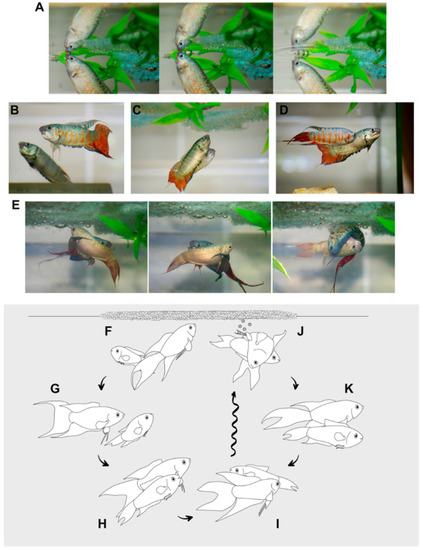- Title
-
Housing, Husbandry and Welfare of a "Classic" Fish Model, the Paradise Fish (Macropodus opercularis)
- Authors
- Rácz, A., Adorján, G., Fodor, E., Sellyei, B., Tolba, M., Miklósi, Á., Varga, M.
- Source
- Full text @ Animals (Basel)
|
Housing conditions for paradise fish. (A) Adult, sexually dimorphic paradise fish pair. Female in the front, male in the back. (B) Adult paradise fish are housed at ~1 fish per 3 L water stocking densities, in covered, environmentally en-riched aquariums. (C) Adolescent (~4 months post-fertilization (mpf)) fish, with not fully developed sexual dimorphism, can be stocked at higher densities. (D) Housing conditions of juvenile paradise fish (~2 fish per 1 L of water). Photo credit: Anita Rácz. |
|
Larval/juvenile development of M. opercularis. (A) A larval/juvenile developmental series of paradise fish. Scale bars are 1 mm. (B) Larval survival rate under different conditions tested. (dpf = day of post-fertilization, wpf = week of post-fertilization, nstart = number of larvae at the beginning of the observation period). Photo credit: Máté Varga. |
|
Reproductive behavior of the paradise fish. (A) Male paradise fish building nest, by ejecting mucus covered bubbles (A,B). (B) Paradise fish males show lateral spread display (LSD) behavior towards female fish in courtship. (C,D) Paradise fish courtship behavior: female fish check nest (C) or refuse male’s invitation by showing aggressive displays (OPE—opercular erection, LSD), vibrating movement (VIB) towards male fish (D), or even escape (ESC). (E) Paradise fish performing circling (CIR) followed by anabantoind embrace (ANE). (F–K) Step by step illustration of courtship behavior at M. opercularis. (F) Male fish building nest (A,B), (G) male fish starts lateral spread display (LHH), (H) male leads female to the bubble nest (LEN), (I) female shows a vertical waggle (VEW) followed by circle swimming (CIRC) under and toward nest, (J) anabantoid embrace (ANE) and release of gametes, (K) swimming inhibition (SIN). Steps I to K are repeated approximately 12–15 times, until the spawning process is finished (2–3 h). Drawing credit: Renáta Hamar, photo credit: Anita Rácz. |
|
Disease symptoms of captive paradise fish. ( |




